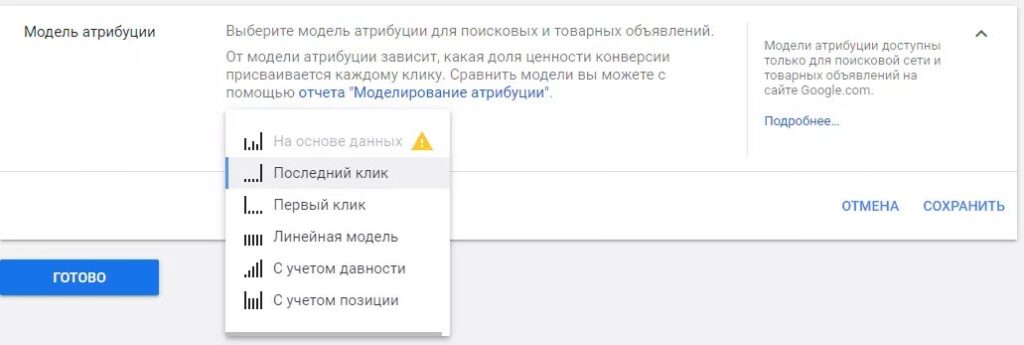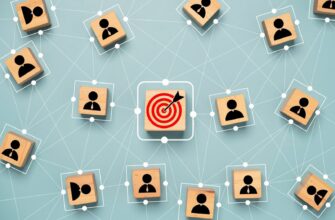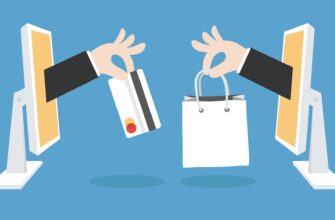- What are different attribution models used for?
- What attribution models are available in Google Ads?
- On the last click
- First click
- Linear model
- Taking into account the period of interaction
- Taking into account the position
- Based on data
- According to the latest transition from Google Ads
- On the last indirect click
- Setting up an attribution model in Google Ads
- Key differences between attribution in Google AdWords and Analytics
- What to consider when choosing an attribution model?
- Common mistakes when setting up an attribution model
Users can arrive at a website from various sources (search results, contextual advertising, social networks). Determining the value of each traffic channel and understanding its contribution to the final conversion rate is the primary goal of any internet marketer.
Attribution models are a mechanism for distributing conversions between different traffic channels, which allows you to establish the value of each platform or assign all conversions to a single channel.
This tool can be used to obtain valuable business information, such as which sources to build your advertising strategy on, what audience the target platform generates, and much more.
How many calls and sales will I get by ordering contextual advertising from you?
I need to calculate the conversion of my website Describe
the task
in the application
Calculate potential ad revenue Google
contextual advertising calculator
Attention! The — attribution model is an important tool for any advertising campaign. Without its competent use, effectiveness will be at a fairly mediocre level.
What are different attribution models used for?
Before making a purchase, users today interact with a variety of advertising channels. They may click on the same ad multiple times. Because of this, it often takes a significant amount of time from the first visit to the site to the decision to purchase.
To track this long journey, they use attribution models in Google. In addition, they allow you to:
- Optimize your advertising budget. If a particular channel, such as banner advertising, is not generating conversions, you can reallocate your budget to more effective traffic sources, such as search advertising.
- Reduce the cost per action (CPA). A properly selected attribution model will show which channels and ads actually lead to conversions.
- Improve bidding strategies. Some models, such as data-driven attribution, work well in conjunction with smart bidding in Google Ads.
- Understand the customer journey. You will be able to see which channels and ads generate leads and conversions. This will allow you to assess the importance of each traffic source and the effectiveness of specific ads and keywords.
What attribution models are available in Google Ads?

Since a user may visit a website several times before purchasing a product or ordering a service, arriving via different search queries from different platforms, marketers need to evaluate the contribution of each of them to the overall conversion rate.
This impact can be tracked using various Google AdWords attribution models. The following models are available:
On the last click
This is the most common attribution model, widely known to those who place online ads. When using this method, Google attributes the conversion to the last source that brought in the user who placed the order. If we compare advertising to big-time sports, we can say it another way: it doesn’t matter who passed the ball to the player, what matters is who scored the goal.
The advantage of this tool is that it is easy to use and understand. However, the last click can hide a whole layer of useful information—the entire previous path of a potential customer from the first click to placing an order. Your strategy will not be complete until you are able to reconstruct the entire chain of customer interaction with the website.
Please note! Most advertisers in AdWords are most familiar with this attribution model.
First click
When using this attribution, priority is given to the user’s first touch with the resource and, accordingly, to the first target request. In other words, whoever made the first pass in the game wins the match.
Linear model
Unlike previous models, the linear model takes into account the entire chain of interactions and assigns the same rating to each channel. It is more complex than previous models, but allows for more accurate results. In sports terminology, all passes that led to a goal are taken into account.
Taking into account the period of interaction
This model is suitable for advertising companies that rely on long sales cycles. Attribution takes into account the entire history of clicks made. However, the click that is closest in time to the conversion date acquires the highest value for the customer.
In this case, the value of the target action decreases every 7 days. That is, the system considers transitions made a week before the target action to be half as important as those that occurred on the day of the application, and those that occurred 14 days ago to be four times less important.
Taking into account the position
In this case, the first and last clicks receive 40% of the total value, and the remaining 20% is distributed among the channels in the middle.
Based on data
When using the Data Driven attribution model, the system takes into account the array of general information that Google Ads collects about users. Based on its algorithms, Google determines the probability of conversion in each specific case.
How many calls and sales will I get by ordering contextual advertising from you?
I need to calculate the conversion of my website Describe
the task
in the application
Calculate potential ad revenue Google
contextual advertising calculator
Important! To connect a data-based attribution model, the system must accumulate a sufficient amount of information. The advertising campaign must run for at least 30 days, the website must receive at least 15,000 visits from Google ads, and there must be at least 600 conversions.
According to the latest transition from Google Ads
In this case, the system attributes the conversion to the last visit to the website that was made via Google AdWords ads. Other advertising channels are not taken into account at all.
This model can be used to identify the most effective queries that lead to conversions more often. However, if traffic from Google ads to your website is only a small part of your total traffic, it is better not to use last-click attribution from Google Ads.
On the last indirect click
This model is the default in Google Analytics. It assigns all conversion value to the last click on any advertising channel, unless it is direct traffic.
It works well for new advertising campaigns where there is not yet enough user data, for example, if there have been fewer than 100 clicks on the website from ads during the entire period of the advertising campaign. With such a small amount of data, other models will not provide an objective picture.
Setting up an attribution model in Google Ads
To set up an attribution model in Google AdWords, go to the “Tools and Settings” menu, then find the “Conversions” subsection in the “Tracking” section:

You can select a different attribution model for each individual conversion. Go to the settings for the desired conversion and select the appropriate attribution model from the drop-down list:

Key differences between attribution in Google AdWords and Analytics

Conversions are calculated differently in these services. Analytics, in particular, separates completed goals and e-commerce transactions.
Let’s look at the main differences between the Google Analytics and AdWords attribution models:
- Default model. Google Ads calculates conversion based on the last click on the website. In Analytics, everything works on the same principle, except for direct channels. For example, a visitor clicked on an ad. A few days later, they opened the website from the search results. Analytics will attribute this conversion to Google/Organic, while AdWords will attribute it to the campaign/ad group/target query that led to the order.
- By conversion date. AdWords counts conversions on the date of the first click, while Analytics counts them on the date of purchase. For example, a customer clicked on an ad on May 11 and made a purchase on May 15. In Google Ads, this conversion will be dated May 11, and in Analytics, it will be dated May 15.
- By the relevance of calculations. In AdWords, updates occur every 3 hours, while in Analytics, they take much longer—up to 9 hours.
- Number of conversions per session. AdWords can count either unique conversions within a single session or all conversions. This can be adjusted using special settings. Analytics counts only one goal per session, while all e-commerce transactions are counted.
- Blocking visitor cookies. In this case, Analytics does not “see” the conversion, but Google Ads registers it;
- Phone calls. If phone number extensions are used in advertising, Google AdWords can record calls of a certain duration as conversions.
- Visits from different devices. AdWords records interactions from all devices, while Analytics only records interactions from the last device (from which the target action was performed).
What to consider when choosing an attribution model?
An effective advertising strategy depends directly on choosing the right model. To select the appropriate attribution model in Google Ads, consider the following factors:
- Determine how much time typically passes between the first visit to your website and the purchase in your field.
- Set the goals of the advertising campaign;
- Determine at which stage of the sales funnel a particular advertising strategy should be used.
For example, you own an online clothing store. The decision-making time from the first click to purchase is two to three weeks.
You launched a broad match search network ad campaign. Evaluating the effectiveness of such a campaign based on the last interaction would be fundamentally wrong, as this type of advertising works perfectly at the top of the sales funnel (it allows potential customers to get acquainted with the brand). Conversions usually occur through other traffic (for example, branded traffic).
Common mistakes when setting up an attribution model
When setting up attribution models in Google Ads, it is important to avoid mistakes that could distort the analysis of advertising effectiveness. Below, we will discuss the most common ones:
- Focusing solely on last-click attribution. With this approach, you may underestimate the importance of media advertising or social networks, which attract customers to the site at the initial stage of interaction. For example, customers may visit the site through search advertising to make a purchase, but they may have initially learned about your offer through other channels.
- Changing attribution models too often. Frequent changes can confuse analytics and complicate tracking of performance dynamics. To understand the effectiveness of a particular model, it is important to accumulate a certain amount of representative data.
- Disregarding negative keywords. Non-targeted queries reduce the effectiveness of any attribution model, as they bring irrelevant traffic to the site. This distorts the data and can lead to incorrect conclusions. To avoid this problem, regularly analyze search queries and add negative phrases to filter out non-targeted visitors and improve attribution accuracy.


















